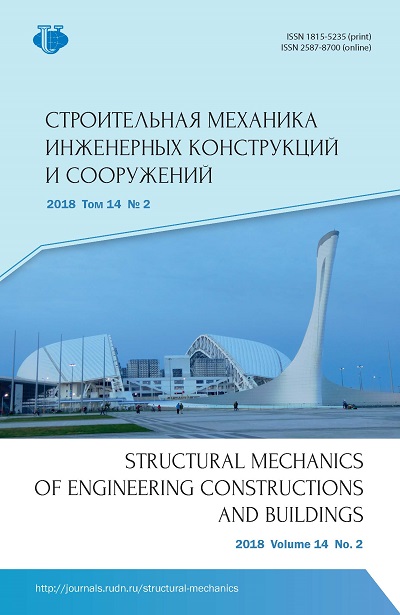The analysis of reinforced concrete slabs strengthened by composite fabrics by the finite element method
- Authors: Agapov V.P1, Nikolaev V.B2, Golovanov R.O1
-
Affiliations:
- Moscow State University of Civil Engineering (National Research University)
- AO “Atomenergoproekt”
- Issue: Vol 14, No 2 (2018)
- Pages: 120-131
- Section: Numerical methods of structures’ analysis
- URL: https://journals.rudn.ru/structural-mechanics/article/view/18647
- DOI: https://doi.org/10.22363/1815-5235-2018-14-2-120-131
Cite item
Full Text
Abstract
The finite element method of calculation of reinforced concrete slabs strengthened with composite fabrics based on carbon fibers, implemented in the PRINS program, is considered. The method is designed for analyzing the stress-strain state of reinforced concrete structures when cracks in concrete and plastic deformations in the reinforcement arise. The calculation is carried out in increments, and at each stage of loading a variable stiffness matrix is used. Its constant part represents the stiffness matrix at the beginning of the loading stage, and the variable one is calculated taking into account the stress-strain state at the end of the current iteration. The variable part of the stiffness matrix, multiplied by the displacement vector found at the previous iteration, is transferred to the right side of the equation system and is considered to be an additional load. When cracks occur or when plastic strains appear, the stresses are corrected in accordance with the specified deformation diagrams. Therefore, at the end of the loading step the equilibrium conditions are checked. If necessary, the external and internal forces are balanced. When considering plastic deformations in concrete and reinforcement, the theory of plastic flow and the Huber - Mises yield criterion, modified taking into account the experimental studies of Kupfer et al., are used. An example of the reinforced concrete slab analysis with different variants of strengthening by composite and without strengthening is given. The results of the calculation are analyzed. The possibility of studying the stress-strain state throughout the entire path of loading of reinforced concrete slabs up to destruction is shown.
About the authors
Vladimir P Agapov
Moscow State University of Civil Engineering (National Research University)
Author for correspondence.
Email: agapovpb@mail.ru
Dr. Sc. (Technical), Prof., Department of Applied Mechanics and Mathematics. Moscow State University of Civil Engineering (National Research University). Russia. Research interests: static, buckling and dynamic analysis of structures by finite element method; development of software for strength analysis
26 Yaroslavskoye Shosse, Moscow, 129337, Russian FederationValerii B Nikolaev
AO “Atomenergoproekt”
Email: agapovpb@mail.ru
Dr. Sc. (Technical), Prof., Chief Researcher, Atomenergoproekt. Research interests: theory of solid reinforced concrete structures.
7 Bakuninskaya St., bldg. 1, Moscow, 107996, Russian FederationRoman O Golovanov
Moscow State University of Civil Engineering (National Research University)
Email: agapovpb@mail.ru
Cand. Sc. (Technical), Associate Professor, National Research Moscow State University of Civil Engineering. Research interests: experimental and computational studies of spatial rod systems of noncanonical form
26 Yaroslavskoye Shosse, Moscow, 129337, Russian FederationReferences
- Kalyanova E.E. (2014). Novyie innovatsionnyie tehnologii: preimuschestva produktov Sika [New innovative technologies: advantages of Sika products]. Stroitelstvo. No 8, 54–58. (In Russ.)
- FRP Repair Materials and Methods. Concrete International. (2005), 27 (1), 66.
- Cardolin A. (2003). Carbon Fibre Reinforced Polymers for Strengthening of Structural Elements. Division of Structural Engineering, Department of Civil and Mining Engineering, Lulea University of Technology, Sweden, 194. (In Russ.)
- Chernyavskiy V.L., Akselrod E.Z. (2004). Primenenie ugleplastikov dlya usileniya zhelezobetonnyih konstruktsiy promyishlennyih zdaniy [The use of carbon plastics to reinforce the reinforced concrete structures of industrial buildings]. Promyishlennoe i grazhdanskoe stroitelstvo, No 3, 37–38. (In Russ.)
- Rekomendatsii po primeneniyu tkanevyih kompozitsionnyih materialov pri remonte zhelezobetonnyih konstruktsiy mostovyih sooruzheniy. Federalnoe Dorozhnoe Agentstvo (Rosavtodor) [Recommendations on the use of fabric composite materials for the repair of reinforced concrete structures of bridge structures. Federal Road Agency (Rosavtodor)]. Moscow, 2013, 55. (In Russ.)
- Rukovodstvo po usileniyu zhelezobetonnyih konstruktsiy kompozitnyimi materialami [Guidelines for reinforcing reinforced concrete structures with composite materials]. NIIJB, (2012). Moscow, 48. (In Russ.)
- MSC NASTRAN (2016). Nonlinear User’s Guide. SOL 400. MSC Software Corporation, 790.
- Basov K.A. (2005). ANSYS: Spravochnik polzovatelya [ANSYS. User's guide]. Moscow: “DMK-Press” Publ., 637. (In Russ.)
- ABAQUS 6.11. Theory manual. DS Simulia. 2011.
- Nabil F. Grace and Singh S.B. (2005). Durability Evaluation of Carbon Fiber-Reinforced Polymer Strengthened Concrete Beams: Experimental Study and Design. ACI Structural Journal. 102 (1), 40–53.
- Bokarev S.A., Smerdov D.N. (2010). Nelineynyiy analiz zhelezobetonnyih izgibaemyih konstruktsiy, usilennyih kompozitsionnyimi materialami [Nonlinear analysis of reinforced concrete bending structures reinforced with composite materials]. Vestnik TGASU, No 2, 113–125. (In Russ.)
- Cedolin L. and Deipoli S. (June 1977). Finite element studies of shear-critical R/C beams. ASCE Journal of the Engineering Mechanics Division, 103 (EM3), 395–410.
- Zienkiewicz O.C. and Taylor R.L. (2005). The Finite Element for Solid and Structural Mechanics. Sixth edition. McGraw-Hill, 631.
- Comité Euro-International du Béton. CEB-FIP Model Code, 1990. Thomas Telford House, London, 1993.
- Agapov V.P. (2005). Metod konechnyih elementov v statike, dinamike i ustoychivosti konstruktsiy [Finite Element Method in Static, Dynamics and Stability of Constructions]. Moscow: ASV Publ., 245. (In Russ.)
- Owen D.R.J., Figueiras J.A. and Damjanic F. (1983). Finite element analysis of reinforced and prestressed concrete structures including thermal loading. Computer Methods in Applied Mechanics and Engineering. 41, 323–366.
- Kupfer H., Hilsdorf H.K. and Rusch H. (August 1969). Behavior of concrete under biaxial stresses. ACI Journal Proceedings. 66 (8), 656–666.
- Chen W.F. (1982). Plastisity in Reinforced Concrete. McGraw-Hill, New York, 261.
- Rukovodstvo po remontu betonnykh i zhelezobetonnykh konstruktsii i gidrotekhnicheskikh sooruzhenii atomnykh stantsii. OAO «Kontsern Rosenergoatom» [Guide to repair of concrete and reinforced concrete structures and hydraulic facilities of nuclear power plants. Rosenergoatom Concern]. (2012), Moscow, 114. (In Russ.)
















